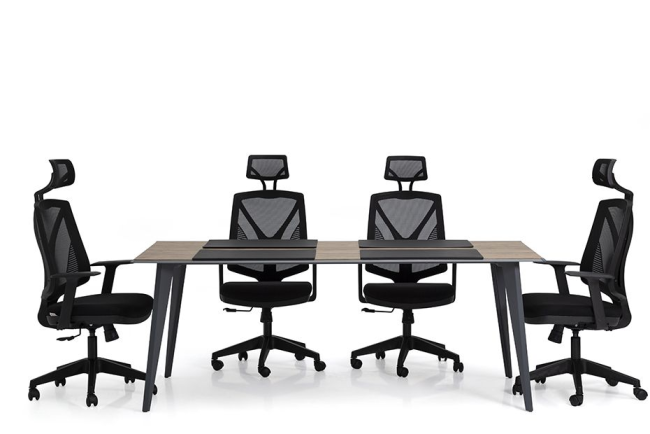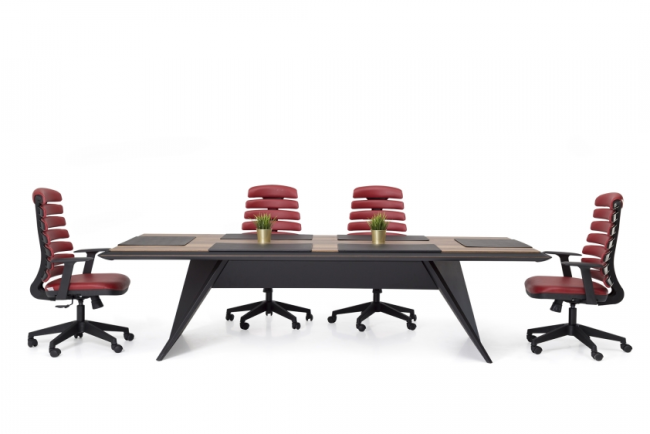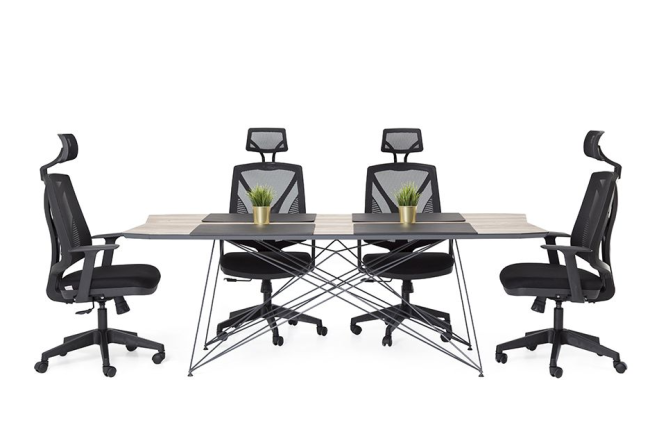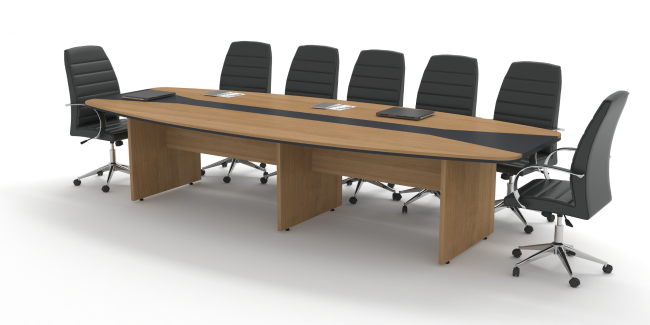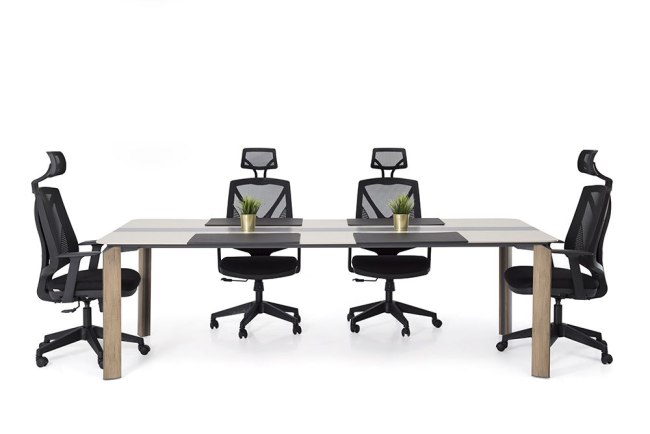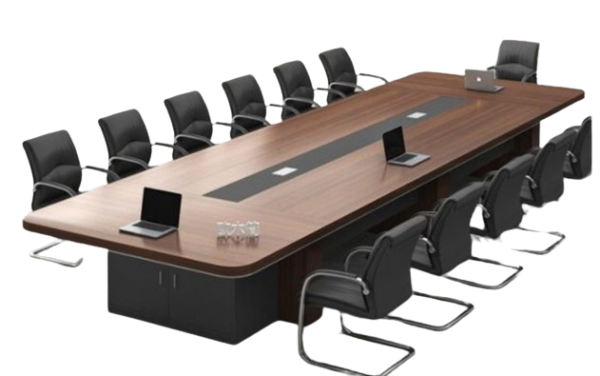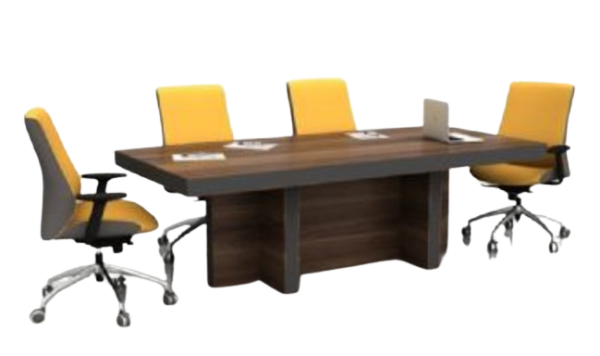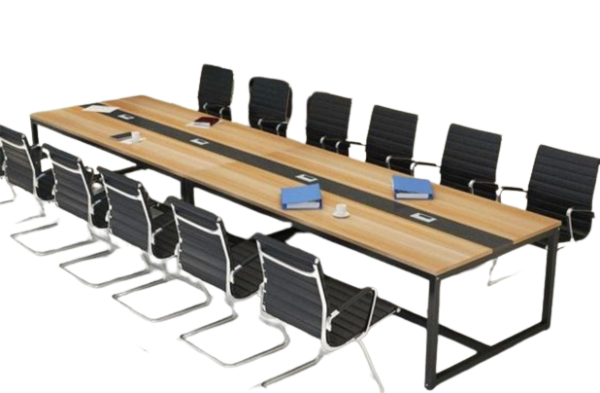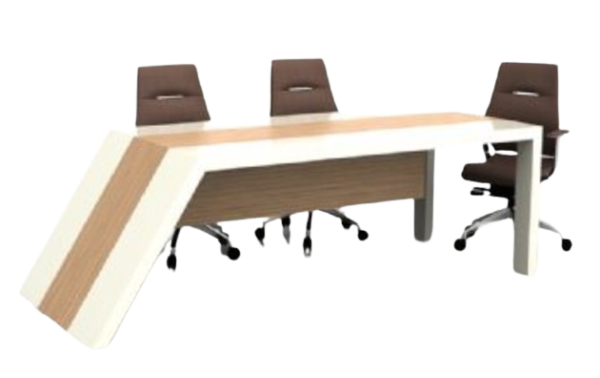Conference table
Conference table
Conference table in workplaces, offices, and even government institutions is considered one of the most important furniture elements. This table plays a central role for employees, executives, and guests to come together and make important decisions. A conference table is not just simple furniture, but also a symbol of a professional environment. The right conference table increases productivity in the work process and creates conditions for more effective communication. These tables are made in different sizes and shapes to suit the needs of every office. In large companies, large-sized and oval-shaped conference tables are more preferred. In small enterprises, square or round-shaped models are chosen. A conference table is important not only for aesthetics but also for functionality. It is essential that documents, laptops, and other work tools can be conveniently placed on the table. In addition, the conference table complements the office image with a design suitable for the work environment. The choice of color, material, and shape is determined according to the corporate style of the office. Conference tables made of glass, wood, or metal details are offered in various options to suit every taste. A conference table allows employees to gather and exchange ideas. Meetings held around this table look more formal and productive. Also, a conference table is one of the details that demonstrate the professionalism of the office to guests. For this reason, every company should choose a quality and aesthetic conference table that suits its needs. Otherwise, the work environment may not leave the necessary impression. A conference table is not just a piece of furniture, but an important tool that contributes to the development of business relations.Conference Table Design and Dimensions
The design and dimensions of a conference table should be chosen according to the general style of the office and the number of employees. In large offices, wide and long tables are chosen so that all employees can sit comfortably. In small offices, more compact models are preferred. The shape of the table is also important: oval, round, or rectangular shapes can change the dynamics of meetings. Oval tables create more equal communication, while rectangular tables create a more formal atmosphere. Minimalism and functionality are the main principles in conference table design. The materials used are mainly wood, MDF, glass, and metal. Wooden tables stand out with their classic look, while glass tables create a sense of modernity. When choosing dimensions, the office space should be considered, and there must be free movement space around the table. The table should also have enough surface for technical tools, microphones, and other work equipment. Attention should also be paid to color harmony in design. Light-colored tables add brightness to the office, while dark colors create a sense of seriousness and prestige. The size of conference tables also affects user comfort. A table with incorrect height can cause employee discomfort and fatigue during long meetings. Therefore, design and size are important not only aesthetically but also ergonomically.
Conference Table Material Selection and Durability
The materials used in the production of conference tables affect both their durability and visual appearance. Traditionally, tables are mainly made from natural wood. This choice creates a classic and sturdy look. However, in modern offices, tables made of MDF or laminated materials are also widely used. These materials are more affordable and provide various design options. Glass-surfaced conference tables add modernity and elegance to the office. Metal details not only enhance durability but also strengthen aesthetic appearance. A conference table should withstand daily use and maintain its form for a long time. For this reason, material selection should be based on quality. Tables made from high-quality materials can be used for many years. Cleaning and maintenance of the material should also be considered when choosing. For example, glass tables leave more stains and require frequent cleaning. Wooden tables can be more sensitive to moisture. Therefore, it is important to choose materials according to the environment in which they will be used. At the same time, producing conference tables from environmentally sustainable materials is one of the modern trends. This choice positively affects both the company’s image and its attitude towards the environment.
The Role of the Conference Table in the Office Environment
A conference table functions not only as a work tool in the office but also as a communication center. Employees gather around this table to share ideas and discuss new projects. The conference table is also the place where decisions are made. Therefore, its impact on the general office atmosphere is significant. A spacious and functional table helps build communication more comfortably. An aesthetically pleasing table strengthens employees’ sense of a professional environment. This also positively affects work motivation and team spirit. A conference table also sends a certain message to office guests. They form an initial impression of the company’s professionalism from the design and placement of the table. Placing the table in the center of the office adds strategic value to the work environment. Meetings held here guide the activities of both employees and management. Thus, the conference table is not just simple furniture but an integral part of office culture.
What to Consider When Choosing a Conference Table?
Several important factors should be considered when choosing a conference table. The most important criterion is the size of the table. Choosing a table that matches the size of the office is essential for comfort and functionality. The second point is material selection. A table made of durable and high-quality material is more suitable for long-term use. Shape selection is also one of the important factors. Oval and round tables ensure equal communication, while rectangular tables are more suitable for formal meetings. The color choice should also match the general interior of the office. Light colors create calmness and openness, while dark colors give a sense of prestige and seriousness. In addition, the functionality of the table should also be considered. For example, tables with special sections for electric outlets and cable management are more convenient. Budget also plays an important role in the selection process. A quality table may be a bit more expensive but is cost-effective for long-term use. Furthermore, warranty and manufacturer reliability should also be considered. By evaluating all these factors, a company can choose the most ideal conference table that meets its needs.
Conference Tables Equipped with Technological Features
In the modern era, conference tables do not only serve as simple tables but are also integrated with technology. These tables can be equipped with built-in microphones, USB outlets, and electrical sockets. This allows employees to use their laptops and other devices comfortably. With the development of video conferencing systems, conference tables are also designed to meet these requirements. Special spaces for screens or projectors are placed in the center of tables. This allows presentations to be conducted more professionally. Smart tables are even equipped with touch screen panels that allow participants to share information in real time. Special sections for cable concealment provide both neatness and safety. Such technological features make the collaboration process more efficient and modern. In addition, some tables are designed with sound insulation systems so that meetings can be more comfortable. Technological conference tables are more commonly used in international companies and large institutions. Such tables not only improve work quality but also demonstrate the modernity of the company.
Advantages of Modular Conference Tables
Modular conference tables stand out for their flexibility and adaptability to various conditions. These tables consist of several parts and can be combined to form a large table or used separately as small tables as needed. Modular tables are very convenient in small offices and multi-purpose halls. Their main advantage is their ability to be adjusted to the needs of the office. For example, they can be set up as a small table for daily meetings or as a large table for big gatherings. Modular tables are also easy to transport and place. For this reason, they are more preferred in multifunctional workplaces. Their materials and shapes can vary: they may consist of wood, metal, or glass parts. Modular tables also create a modern look aesthetically. Employees can communicate more comfortably around such tables. Another advantage of these tables is their cost-effectiveness since one table can serve multiple purposes. In modern office designs, the popularity of modular conference tables is increasing.
Comparison of Large and Small Conference Tables
Conference tables can be divided into two main categories based on size: large and small tables. Large conference tables are designed to accommodate more employees and guests. These tables are mainly located in the conference halls of large companies. Their advantage is that all participants can gather together and communicate comfortably. However, large tables take up a lot of space in the office, which may create certain limitations. Small conference tables are more suitable for startups and small enterprises. They can be placed anywhere in the office due to their compact size. Small tables create a more intimate and informal environment. These tables are ideal for short meetings, discussions, and brainstorming sessions. Both types of tables have their advantages and disadvantages. The choice depends on the company’s size, the number of employees, and the requirements of the work environment. Thus, the size factor becomes one of the main criteria when choosing a conference table.
Psychological Impact of Conference Tables
A conference table is not only physical furniture but also an element that affects the psychology of employees. The shape and placement of the table can change the tone of communication among employees. Round tables create equal communication and allow employees to express their opinions more openly. In rectangular tables, management is more prominent, creating a formal and hierarchical environment. The color of the table also affects the emotional state of employees. Light colors create calmness and openness, while dark colors form a formal and serious atmosphere. The lighting and ventilation of the space where the table is placed also play an important role. Meetings held in a comfortable environment are more productive. Psychological comfort also supports employees in presenting creative ideas. A conference table also reflects the culture of the company. Guests who see this environment gain an initial impression of the company’s style and values. Therefore, choosing a conference table is important not only practically but also psychologically.
Maintenance and Cleaning of Conference Tables
Since a conference table is designed for long-term use, its regular maintenance and cleaning are important. During the day, various documents, pens, drinks, and other items are placed on the table, so dust and stains are inevitable. Wooden-surfaced tables can be sensitive to moisture, so care should be taken not to spill water or hot drinks on them. Fingerprints appear quickly on glass tables and require frequent cleaning. Metal parts should be protected against oxidation. Cleaning a conference table is important not only from a hygienic perspective but also aesthetically. A clean and well-maintained table gives employees positive energy and improves the overall appearance of the office. A cleaning schedule set by the company is very useful in this regard. Especially in large conference halls, daily cleaning is essential as the table is frequently used. Harsh chemicals should not be used during cleaning, as they may damage the surface. Instead, special furniture cleaners are more appropriate. To ensure longevity, applying a protective coating to the conference table may also be beneficial.
Design Trends and Innovations in Conference Tables
In modern times, several new trends are observed in conference table design. Minimalism and functionality come to the forefront as the main criteria. Simpler forms, straight lines, and neutral colors dominate office interiors. At the same time, interest in natural materials is increasing. The combination of wood and glass is widely used in modern offices. Modular tables have also become a trend in design. They are notable for both practicality and aesthetics. Another innovation is the use of eco-friendly materials. Since companies give more importance to sustainability, they prefer tables made of recycled materials. Technological integration also plays an important role in new trends. Built-in USB outlets, cable management systems, and smart functions have already become integral parts of modern conference tables. Color preferences have also changed – light and pastel tones add calmness and comfort to the office environment. Alongside aesthetics, ergonomics is also a key part of design. Comfortable seating angles and proper table height help protect employees’ health. Innovations also include personalized design options. Companies can apply their corporate colors and logos to the surface of tables.
Price Range and Budget-Friendly Options for Conference Tables
The price of conference tables varies depending on several factors. First of all, material selection directly affects the price. Tables made of natural wood are more expensive, while models made of MDF and laminated material are more affordable. Glass and metal combination tables fall into the medium to high price range. The price of modular tables depends on the number of parts. Tables with technological features belong to the highest price category. Companies with limited budgets may prefer simpler models. However, choosing a quality table for long-term use is more cost-effective. This is because cheap and low-quality material tables wear out quickly and require frequent replacement. Warranty period should also be considered when choosing. Good manufacturers provide long-term warranties for tables. Online stores and furniture fairs offer a wide selection of various price ranges. Thus, every company can easily find a conference table suitable for its budget.
Impact of Conference Tables on Business Relations
A conference table is not only furniture but also an important element that affects the formation of business relations. Since meetings take place around this table, the atmosphere it creates is very important. A comfortable and aesthetic table helps employees express themselves more freely. This increases productivity in collective work processes. For guests, a conference table is also a signal. They form an initial opinion about the company by looking at the design, size, and placement of the table. A large and impressive table shows the strength and position of the company. A simpler and more comfortable table demonstrates that friendly communication is preferred. A conference table also creates a psychological environment for decision-making. Round tables are more suitable for equal communication. This allows employees to share their ideas openly. Thus, a conference table is one of the factors that directly affects a company’s business relations.
Get a quote with one click!
Fill out the form and get a private individual offer for your business as soon as possible.
